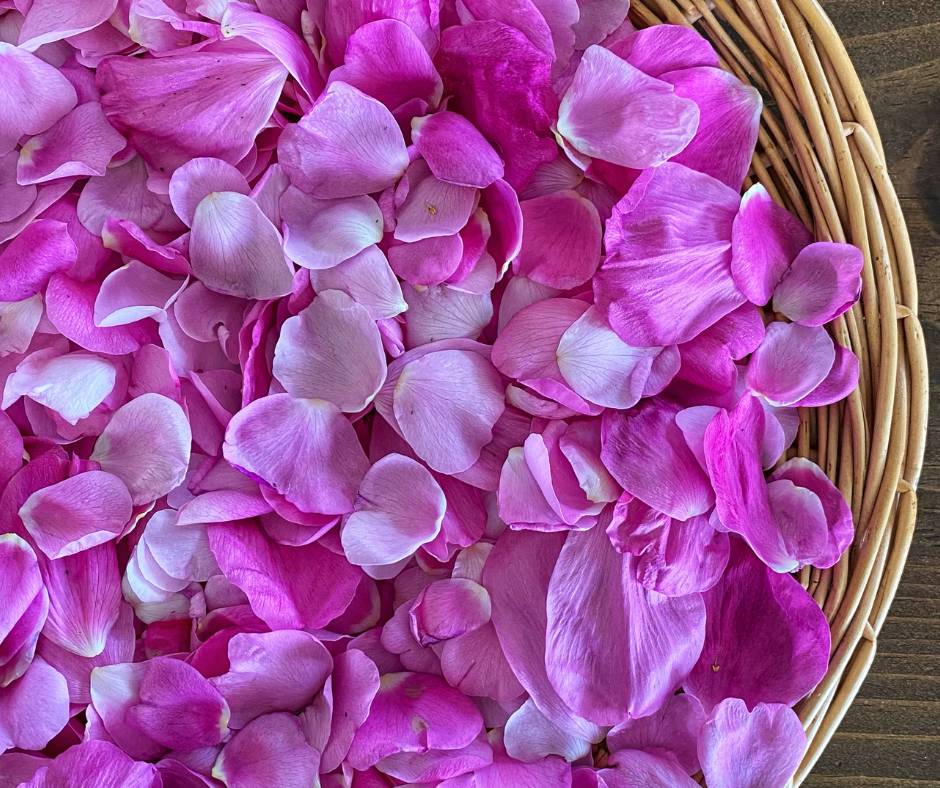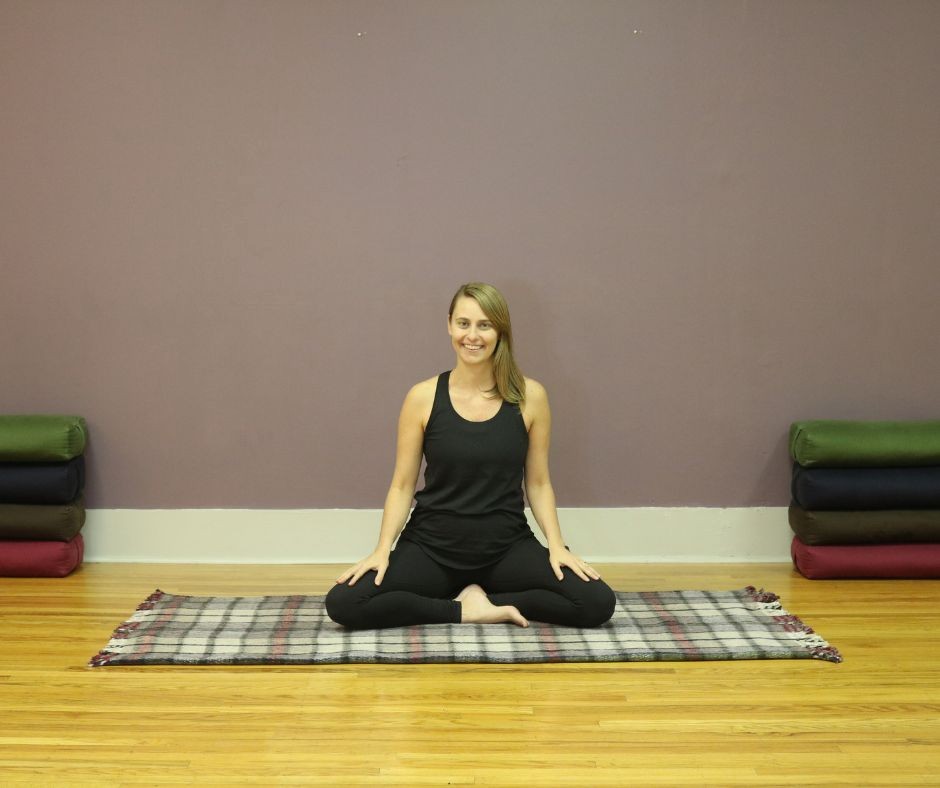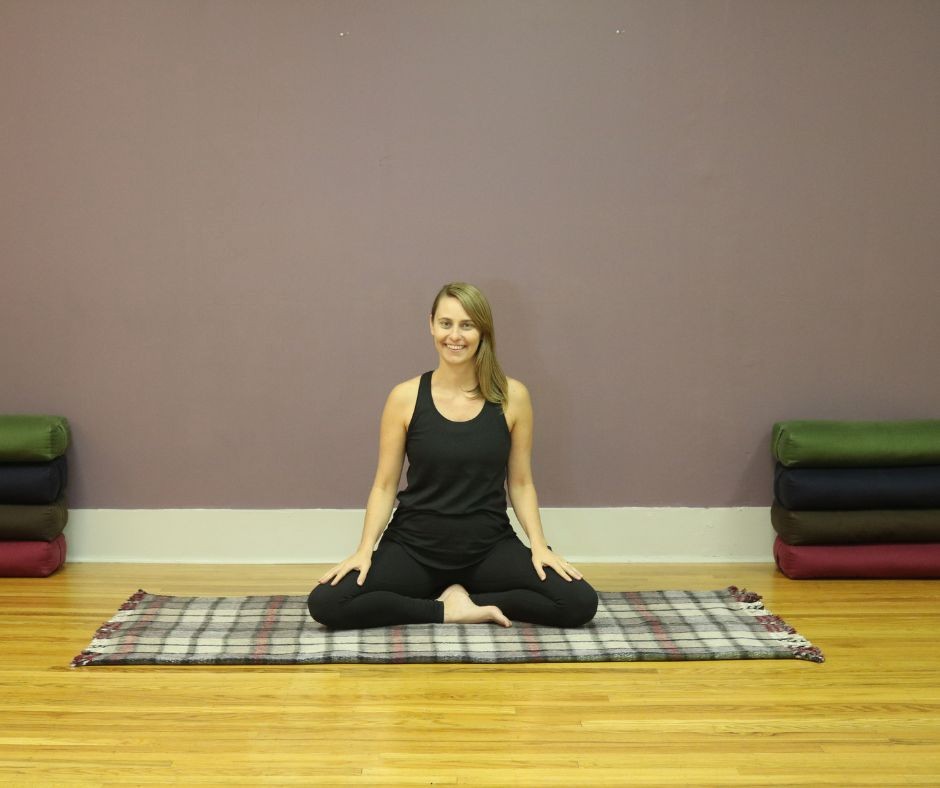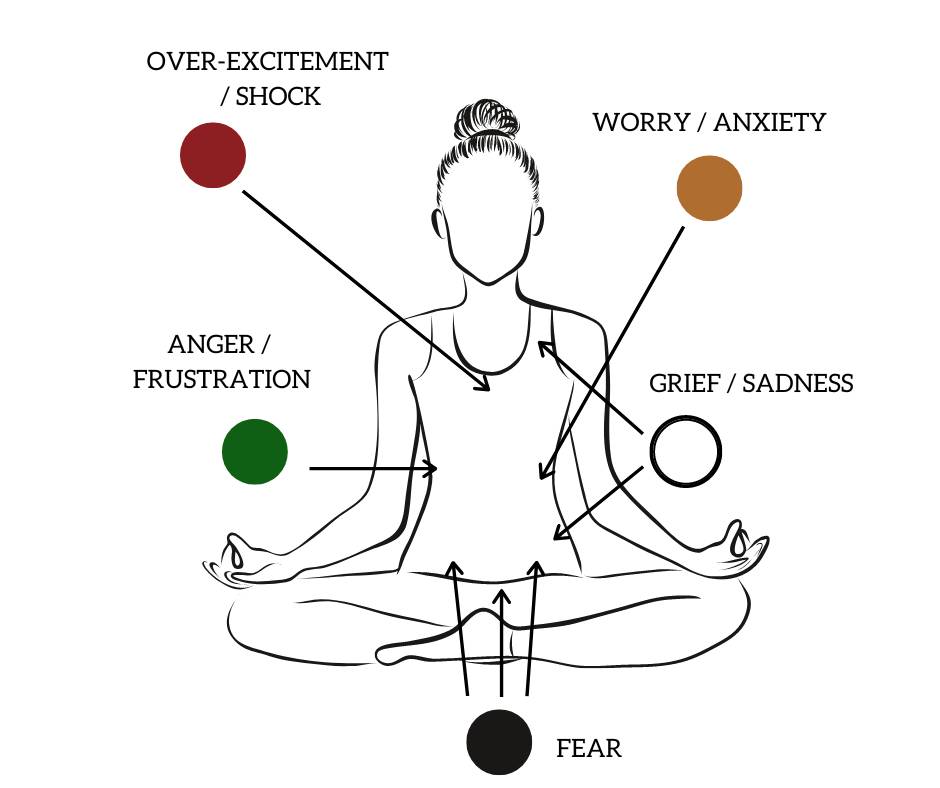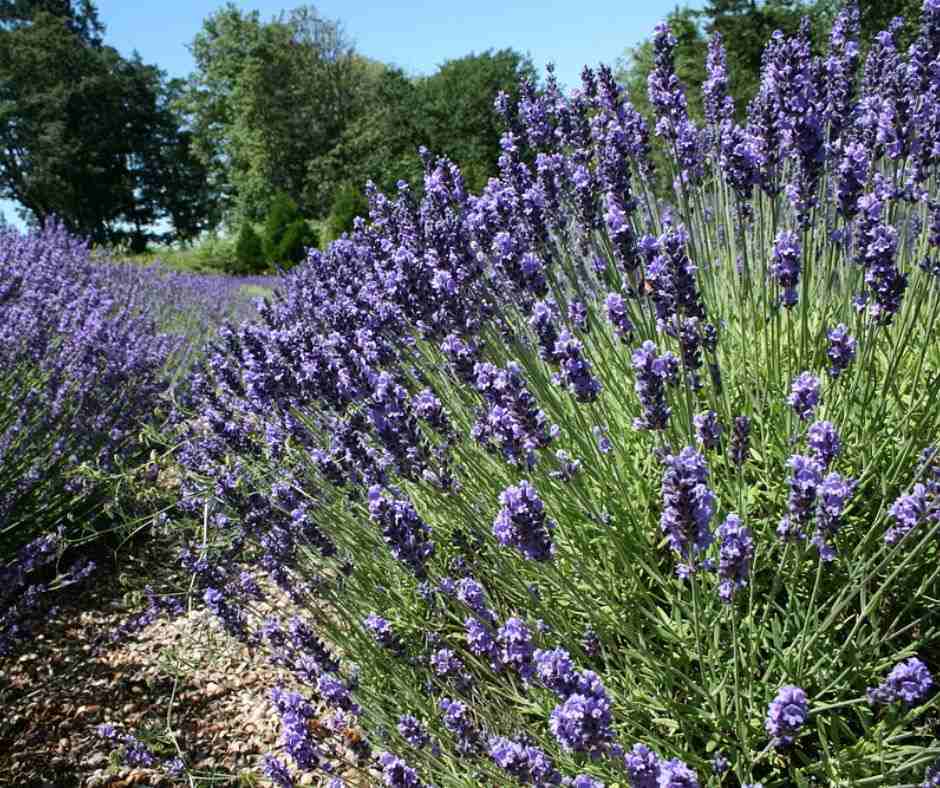Summer is in full swing here, and I’ve been enjoying the arrival of swifts and swallows swooping through the air, the lengthening evenings, and the warm air. This time of year, it’s a delight to make medicine with wild rose, which is plentiful and popping up everywhere in meadows and ditches right now.
Rose medicine is one of my favourites to work with, as it’s such a special heart medicine. With the year we’ve had, it feels very appropriate to soothe our aching hearts with the gifts of this magical plant. Read on to learn more!
The Summer, Fire Element, and Heart Medicine
In both Chinese Medicine and Ayurveda (the medical system of India and yoga), summer is a time when fire increases. It’s a time of increased connection, joy, and activity, but it’s also a time when we need to balance fire so that it doesn’t deplete us as it burns out of control.
In Taoist and Chinese traditions, the summer and fire element are a significant time for the energetic Heart system. The Heart system is considered the emperor; it not only regulates the circulation of blood, but it also oversees our mental and emotional states and communication. When fire and the Heart are out of balance or in excess, we can experience heat signs such as rashes, insomnia, excessive sweating, anxiety, and even mania.
The Healing Power of Rose Medicine
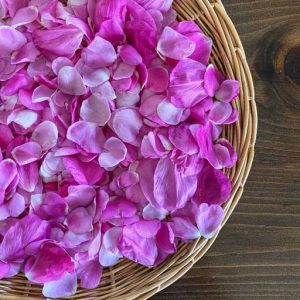 Roses have been (and still are) well-loved in many places and cultures around the world.
Roses have been (and still are) well-loved in many places and cultures around the world.
Cultivating roses likely originated in Persia, but it soon spread. The Greeks and Romans used the beautiful blooms, and, of course, the rose captured the hearts of many artists worldwide, leading to poems, stories, and paintings dedicated to this beautiful and scent-filled flower. Today, there are many thousands of varieties of roses.
Rose medicine is mildly astringent and supports the emotional heart during times of stress, depression, or overwhelm. In particular, volatile oils (their aromatic compounds) calm the nervous system and can improve mood.
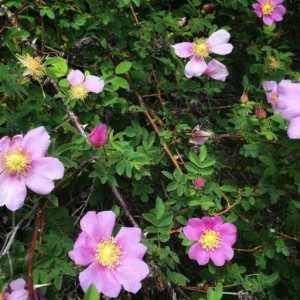 GATHERING ROSE: Your first step in creating rose medicine for yourself is wildcrafting. Rose is easy to identify once you know it, but check with an identification guide if you’re unsure. You can use all varieties of rose for the recipes below, although I prefer harvesting wild rose versus cultivated varieties.
GATHERING ROSE: Your first step in creating rose medicine for yourself is wildcrafting. Rose is easy to identify once you know it, but check with an identification guide if you’re unsure. You can use all varieties of rose for the recipes below, although I prefer harvesting wild rose versus cultivated varieties.
When collecting plants for your healing remedies, remember to offer gratitude, only take a small amount from each plant, and only take what you need. Wild rose is abundant, and there’s plenty to go around! Make sure you’re harvesting in an allowable place, your plant has not been sprayed, and it’s in a location away from traffic and/or other human activity.
It’s usually suggested that you gather rose petals on a dry morning. Place them in a basket or container where the petals won’t bruise. For the recipes below, only pick the petals. Leave the rest of the flower, as he remainder turns into rose hips later in the fall!

Roses have been (and still are) well-loved in many places and cultures around the world.
Cultivating roses likely originated in Persia, but it soon spread. The Greeks and Romans used the beautiful blooms, and, of course, the rose captured the hearts of many artists worldwide, leading to poems, stories, and paintings dedicated to this beautiful and scent-filled flower. Today, there are many thousands of varieties of roses.
Rose medicine is mildly astringent and supports the emotional heart during times of stress, depression, or overwhelm. In particular, volatile oils (their aromatic compounds) calm the nervous system and can improve mood.

GATHERING ROSE: Your first step in creating rose medicine for yourself is wildcrafting. Rose is easy to identify once you know it, but check with an identification guide if you’re unsure. You can use all varieties of rose for the recipes below, although I prefer harvesting wild rose versus cultivated varieties.
When collecting plants for your healing remedies, remember to offer gratitude, only take a small amount from each plant, and only take what you need. Wild rose is abundant, and there’s plenty to go around! Make sure you’re harvesting in an allowable place, your plant has not been sprayed, and it’s in a location away from traffic and/or other human activity.
It’s usually suggested that you gather rose petals on a dry morning. Place them in a basket or container where the petals won’t bruise. For the recipes below, only pick the petals. Leave the rest of the flower, as he remainder turns into rose hips later in the fall!
Rose Medicine Recipes
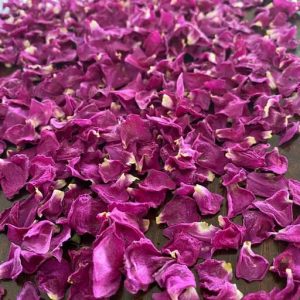 Harvested rose petals can be added to many foods and self-care products. I especially enjoy drying the petals and adding them to teas and bath salts for use during the winter.
Harvested rose petals can be added to many foods and self-care products. I especially enjoy drying the petals and adding them to teas and bath salts for use during the winter.
When making the remedies below, be sure that your petals are dry. There’s no need to wash them after picking – shake them off or let them sit to ensure any debris or small bugs fall off.
Here are a few other recipes for using this beautiful summertime ally:
Rose Oil – I love making this remedy and using it for my seasonal self-massage oil in summer. Rose essential oil is costly, as each drop of oil takes thousands of roses. This oil, instead, has a base of carrier oil (such as olive oil or almond oil), but it carries the heart-soothing scent of rose.
- Fill a jar with freshly picked rose petals.
- Cover the petals in a good-quality massage oil like sweet almond oil or even olive oil. Ensure the mixture is stirred to remove air pockets and that the petals are completely covered.
- Add about 1/4 tsp vitamin E as a preservative (this can be found at health food stores)
- Let sit 2-4 weeks (sunlight will help the extraction process, but you could also keep it in the dark and wait longer if you don’t want the sunlight to degrade the oil).
- Use on skin as a moisturizer!
Rose Honey – A beautiful way to enjoy the scent and flavour of rose in your tea, or by the spoonful!
- Combine some high-quality honey and your fresh rose petals in a clean jar.
- Press petals down so that they’re completely covered in honey.
- OPTION 1: Let it sit in a warm sunny place for a few weeks to a month.
- OPTION 2: Warm the honey and petal mixture in a double boiler for about 12-24 hours (do not cook! This will harm the beneficial components in the honey).
- After the extraction process, some people strain the petals out by gently warming the honey in a pot of hot water (or double boiler) and straining it into a clean jar (be sure to squeeze out every drop!). I prefer to keep the petals in the honey and eat them as I go.
Rose Water – A cooling and refreshing way to use rose on the face and skin. I’ve included the quick and easy method of making rose water below. To make a proper hydrosol takes more equipment and time, but I think you’ll still love the precious scented rose water from this method.
- Place rose petals in a pot with distilled water. Cover the roses, but don’t use too much water as your rose water will then be too diluted.
- Simmer petals in water for about 10- 15 minutes.
- Strain and store in the fridge. With this method, your rose water will last a couple of weeks.
- Use on your face for a quick cool-down spritz, or in your bath.
Rose Vinegar – A wonderful addition to salads (and you can use it on bug bites too)
- Combine fresh rose petals and apple cider vinegar in a clean jar. Make sure petals are covered.
- Close the jar with the lid and let it sit for a couple of weeks (the vinegar will turn a red/pink colour), shaking regularly.
- Strain petals out of the vinegar and enjoy on your next salad!
I hope this gives you some ideas on how to use roses in your home and your kitchen!
Want to learn more? We’re launching A Year of Home Herbal Medicine soon. Get on the early notice list here.

Harvested rose petals can be added to many foods and self-care products. I especially enjoy drying the petals and adding them to teas and bath salts for use during the winter.
When making the remedies below, be sure that your petals are dry. There’s no need to wash them after picking – shake them off or let them sit to ensure any debris or small bugs fall off.
Here are a few other recipes for using this beautiful summertime ally:
Rose Oil – I love making this remedy and using it for my seasonal self-massage oil in summer. Rose essential oil is costly, as each drop of oil takes thousands of roses. This oil, instead, has a base of carrier oil (such as olive oil or almond oil), but it carries the heart-soothing scent of rose.
- Fill a jar with freshly picked rose petals.
- Cover the petals in a good-quality massage oil like sweet almond oil or even olive oil. Ensure the mixture is stirred to remove air pockets and that the petals are completely covered.
- Add about 1/4 tsp vitamin E as a preservative (this can be found at health food stores)
- Let sit 2-4 weeks (sunlight will help the extraction process, but you could also keep it in the dark and wait longer if you don’t want the sunlight to degrade the oil).
- Use on skin as a moisturizer!
Rose Honey – A beautiful way to enjoy the scent and flavour of rose in your tea, or by the spoonful!
- Combine some high-quality honey and your fresh rose petals in a clean jar.
- Press petals down so that they’re completely covered in honey.
- OPTION 1: Let it sit in a warm sunny place for a few weeks to a month.
- OPTION 2: Warm the honey and petal mixture in a double boiler for about 12-24 hours (do not cook! This will harm the beneficial components in the honey).
- After the extraction process, some people strain the petals out by gently warming the honey in a pot of hot water (or double boiler) and straining it into a clean jar (be sure to squeeze out every drop!). I prefer to keep the petals in the honey and eat them as I go.
Rose Water – A cooling and refreshing way to use rose on the face and skin. I’ve included the quick and easy method of making rose water below. To make a proper hydrosol takes more equipment and time, but I think you’ll still love the precious scented rose water from this method.
- Place rose petals in a pot with distilled water. Cover the roses, but don’t use too much water as your rose water will then be too diluted.
- Simmer petals in water for about 10- 15 minutes.
- Strain and store in the fridge. With this method, your rose water will last a couple of weeks.
- Use on your face for a quick cool-down spritz, or in your bath.
Rose Vinegar – A wonderful addition to salads (and you can use it on bug bites too)
- Combine fresh rose petals and apple cider vinegar in a clean jar. Make sure petals are covered.
- Close the jar with the lid and let it sit for a couple of weeks (the vinegar will turn a red/pink colour), shaking regularly.
- Strain petals out of the vinegar and enjoy on your next salad!
I hope this gives you some ideas on how to use roses in your home and your kitchen!
Want to learn more? We’re launching A Year of Home Herbal Medicine soon. Get on the early notice list here.

